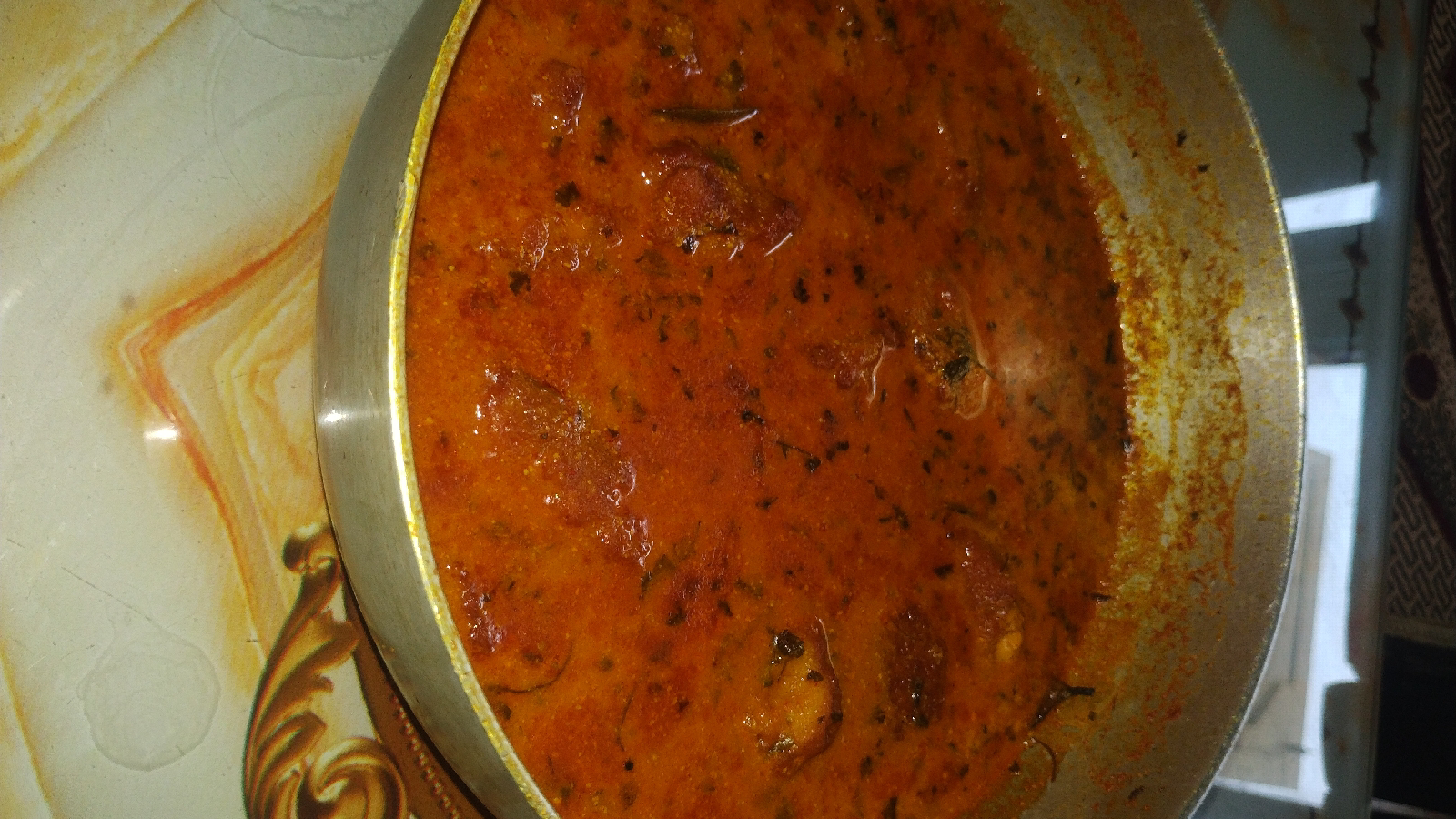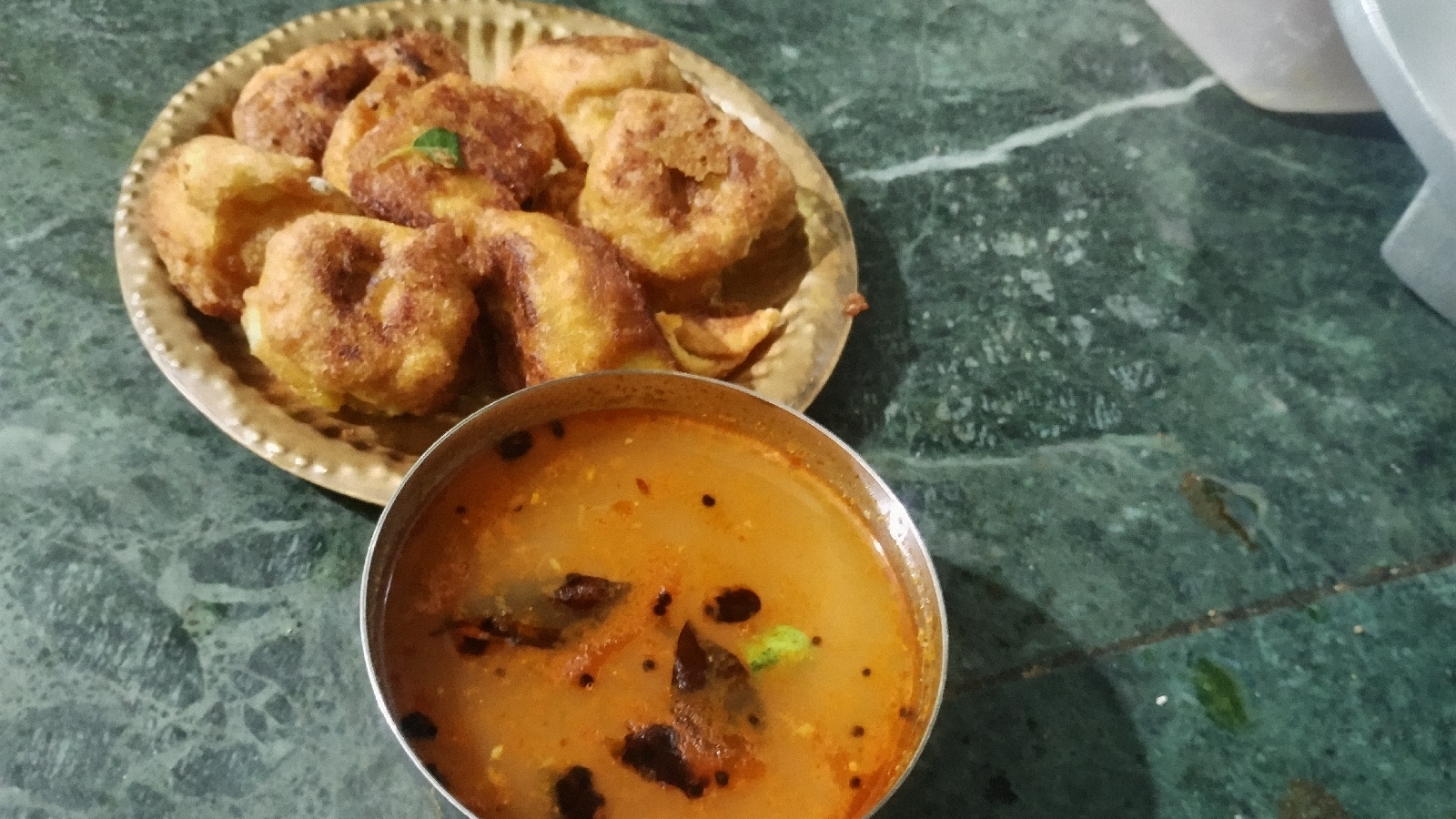रसम बनाने में लगने वाली सामग्री : 1. अरहर दाल : आधी छोटी कटोरी
2. टमाटर : 4
3. अदरक : करीब एक इंच टुकड़ा
4. हरी मिर्च : 4से 5
5. धनियां पाउडर : 1 टेबल स्पून
6. जीरा पाउडर : 1/2 टेबल स्पून
7. कश्मीरी लाल मिर्च पाउडर : 2 टेबल स्पून
8. सांबर मसाला : 3 टेबल स्पून
9. करी पत्ता : 10 से 12 पत्ता
10. पीली सरसों : 1/2 टेबल स्पून
11. इमली का रस : आधा कटोरी
12. हींग : चुटकी भर
13. सरसो तेल
14. हल्दी पाउडर : 1/2 टेबल स्पून
15. सूखी लाल मिर्च : 6
16. बिना छिलके वाली उरद दाल : 1 टेबल स्पून
रसम बनाने की विधि :
रसम बनाने के लिए सबसे पहले अरहर दाल को अच्छे से धो कर, प्रेशर कुकर में एक ग्लास पानी, हल्का नमक और आधी छोटी चम्मच हल्दी पाउडर डालकर 4 से पांच सीटी लगा लें।
अब एक पतीले में पानी डालकर उसमें टमाटर को उबाल लें, पांच से सात मिनट बाद टमाटर को निकाल कर उसका छिलका उतार लें, और फिर मिक्सी के जार में टमाटर, हरी मिर्च और अदरक को कद्दूकस कर के डाल कर सभी को अच्छी तरह से पीस कर उसका बारीक पेस्ट बना लें।
अब गैस पर एक पैन गरम करें, जैसे ही पैन गरम हो जाए तो उसमें सरसो डाल दें, जब सरसो तरकने लगे तो, तेल डाल कर फिर उसमें हींग, सूखी लाल मिर्च 4, करी पत्ता, और उरद दाल को धो कर डाल दें।
जब उरद दाल हल्का सुनहरा होने लगे , तो उसमें टमाटर का पेस्ट, हल्दी पाउडर, धनियां पाउडर, जीरा पाउडर, कश्मीरी लाल मिर्च पाउडर और सांबर मसाला डाल कर , मसालों को धीमी आंच पर अच्छे से भून लें, जब मसाला अच्छी तरह भुन जाए तो उसमें इमली का रस डाल कर एक दो मिनट और भूनें।
अब जो अरहर दाल उबाल कर रखा था उसे भी डाल कर और फिर 5 से 6 ग्लास पानी डाल दें, और स्वादानुसार नमक डाल कर अच्छी तरह से उबलने दें। रसम को गाढ़ा नहीं रखना है, बिल्कुल पतला रखना है। पानी आप अपने जरूरत के हिसाब से कम या ज्यादा डाल सकते हैं।
अब रसम में तड़का लगाने के लिए एक तड़का पैन गरम करें, जैसे ही पैन गरम हो जाए तो उसमें पीली सरसों डाल कर उसे तड़कने दें,और फिर तेल डाल कर सूखी लाल मिर्च और करी पत्ता डाल दें। अब रसम को चूल्हे से उतार लें और उसमें ये तड़का डाल दें।
लीजिए तैयार है बहुत ही तीखी और चटपटी रसम।
बड़ा बनाने में लगने वाली सामग्री :
1. बिना छिलके वाली उरद दाल : 1/2 kg
2. साबुत जीरा : 1 टेबल स्पून
3. हरी मिर्च : 5 से 6
4. अदरक : 1 इंच टुकड़ा
5. बारीक कटा हुआ धनियां पत्ता
6. सरसो तेल
बड़ा बनाने की विधि :
उरद दाल को तीन चार बार अच्छे से धो कर उसमें पानी डाल कर रात भर भिगो दें। सुबह दो तीन बार और अच्छे से धो लें और फिर मिक्सी में थोड़ा दरदरा पीस लें। पीसने में पानी बिल्कुल कम डालें, थोड़ा गाढ़ा पीसना है, पतला बिल्कुल नहीं करना है, वरना बड़े अच्छे नहीं बनेंगे।
अब पीसी हुई दाल को किसी बरतन में निकाल कर उसे हाथों से अच्छे से फेटना है, दाल अच्छी तरह फिटी या नहीं उसे चेक करने के लिए एक ग्लास में पानी लें, और थोड़ी सी दाल के पेस्ट को ग्लास में डालें, अगर दाल का पेस्ट पानी के ऊपर तैरने लगे तो, समझना की दाल अच्छे से बड़ा बनाने के लिए तैयार है, और अगर दाल का पेस्ट पानी के अंदर बैठ जाए तो दाल को थोरी और फेटने की जरूरत है।
अब फेटे हुए दाल के पेस्ट में, कटी हुई हरी मिर्च, बारीक कटा हुआ हरा धनिया, साबुत जीरा,और अदरक को पीस कर डाल दें। अब स्वादानुसार नमक डाल दें।
गैस पर एक पैन गरम करें, और फिर उसमें तेल डाल कर अच्छी तरह गरम करें। जैसे ही तेल गरम हो जाए तो उसमें छोटे छोटे बड़े डाल कर मीडियम आंच पर उलट पलट कर क्रिस्प होने तक उसे अच्छे से फ्राई कर लें, और फिर एक प्लेट में निकाल लें। इसी तरह से सारे बड़े को फ्राई कर लें।
लीजिए रसम बड़ा बन कर तैयार है,बहुत ही तीखा और चटपटा रसम बड़ा को गरमा गरम सर्व करें।
Ingredients for making Rasam:
1. Arhar dal : half a small bowl
2. Tomatoes : 4
3. Ginger : about one inch piece
4. Green chilies : 4 to 5
5. Coriander powder : 1 tablespoon
6. Cumin powder : 1/2 tablespoon
7. Kashmiri red chili powder : 2 tablespoon
8. Sambar masala : 3 tablespoon
9. Curry leaves : 10 to 12 leaves
10. Yellow mustard : 1/2 tablespoon
11. Tamarind juice : half a bowl
12. Asafoetida : a pinch
13. Mustard oil
14. Turmeric powder : 1/2 tablespoon
15. Dried red chilies : 6
16. Unpeeled urad dal : 1 tablespoon
Method of making Rasam:
To make Rasam, first wash the pigeon peas properly, add a glass of water, a little salt and half a teaspoon of turmeric powder in a pressure cooker and cook for 4 to 5 whistles.
Now put water in a pot and boil tomatoes in it, after five to seven minutes take out the tomatoes and peel them, and then put grated tomatoes, green chillies and ginger in a mixer jar, grind them all well and make a fine paste.
Now heat a pan on the gas, as soon as the pan gets hot, put mustard seeds in it, when the mustard seeds start crackling, add oil and then add asafoetida, 4 dry red chillies, curry leaves, and washed urad dal.
Now heat a pan on the gas, as soon as the pan gets hot, put mustard seeds in it, when the mustard seeds start crackling, add oil and then add asafoetida, 4 dry red chillies, curry leaves, and washed urad dal. When the urad dal turns light golden, add tomato paste, turmeric powder, coriander powder, cumin powder, Kashmiri red chilli powder and sambar masala and fry the spices well on low flame. When the masala is fried well, add tamarind juice and fry for a minute or two.
Now add the boiled tur dal and then add 5 to 6 glasses of water and add salt as per taste and let it boil well. The rasam should not be thick, it should be very thin. You can add more or less water as per your requirement.
Now heat a tadka pan to add tempering to the rasam. As soon as the pan gets hot, add yellow mustard seeds and let it crackle. Then add oil and add dried red chillies and curry leaves. Now remove the rasam from the stove and add this tempering to it.
Here, very spicy and tangy rasam is ready.
Ingredients for making Bada :
1. Unpeeled Urad Dal : 1/2 kg
2. Whole Cumin Seeds : 1 Tablespoon
3. Green Chillies : 5 to 6
4. Ginger : 1 inch piece
5. Finely chopped coriander leaves
6. Mustard Oil
Method of making Bada :
Wash Urad Dal three to four times, add water and soak it overnight. Wash it two to three times more in the morning and then grind it coarsely in the mixer. Add very less water while grinding, grind it a little thick, do not make it thin at all, otherwise Bada will not turn out well.
Now take out the grinded dal in a vessel and beat it well with your hands. To check whether the dal is well mixed or not, take water in a glass and put some dal paste in it. If the dal paste starts floating on the water, then understand that the dal is ready to make bada. And if the dal paste settles down inside the water, then the dal needs to be beaten a little more.
Now add chopped green chilies, finely chopped coriander leaves, whole cumin seeds, and grinded ginger to the beaten dal paste. Now add salt according to taste.
Heat a pan on the gas and then add oil to it and heat it well. As soon as the oil is hot, put small badas in it and fry them well by turning them over on medium flame till they become crispy and then take them out in a plate. Fry all the badas in the same way.
Here Rasam Bada is ready, serve it very spicy and tangy Rasam Bada hot.












